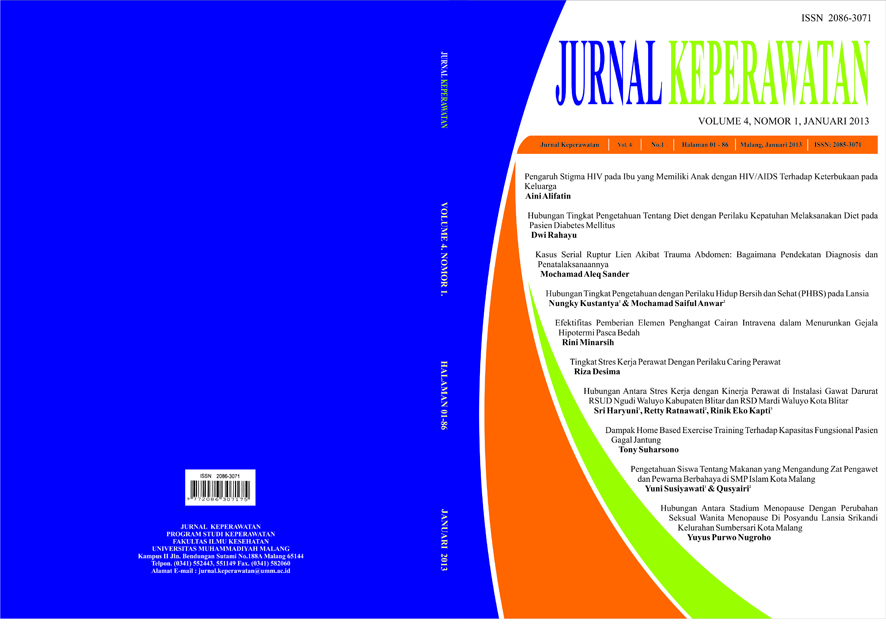KASUS SERIAL RUPTUR LIEN AKIBAT TRAUMA ABDOMEN: BAGAIMANA PENDEKATAN DIAGNOSIS DAN PENATALAKSANAANNYA
DOI:
https://doi.org/10.22219/jk.v4i1.2377Keywords:
abdominal blunt trauma, lacerations of the spleen capsule, splenic pedicle avulsion, hypovolemic shock, irritation of the diaphragm, splenectomyAbstract
KASUS SERIAL RUPTUR LIEN AKIBAT TRAUMA ABDOMEN: BAGAIMANA PENDEKATAN DIAGNOSIS DAN PENATALAKSANAANNYASerial cases rupture of spleen due to abdominal trauma: How to diagnose and the treatment?
Mochamad Aleq Sander
Fakultas Kedokteran Universitas Muhammadiyah MalangJalan Bendungan Sutami 188A Malang 65145 e-mail: aleq.sander@yahoo.com
ABSTRAK
Salah satu organ kita yang paling sering mengalami cedera pada suatu trauma tumpul pada daerah perut atau toraks kiri bagian bawah adalah lien. Penyebab utamanya adalah cedera langsung atau tidak langsung yang menyebabkan laserasi kapsul lien dan avulsi pedikel lien sebagian atau menyeluruh. Pada trauma lien yang perlu diperhatikan adalah adanya tanda-tanda perdarahan yang memperlihatkan keadaan hipotensi, syok hipovolemik, dan nyeri abdomen pada kuadran atas kiri dan nyeri pada bahu kiri karena iritasi diafragma. Perdarahan lambat yang terjadi kemudian pada trauma tumpul lien dapat terjadi dalam jangka waktu beberapa hari sampai beberapa minggu setelah trauma. Untuk menentukan diagnosis trauma tumpul maka diperlukan anamnesis adanya riwayat trauma abdomen bagian kiri bawah, pemeriksaan fisik, dan pemeriksaan penunjang, yang menunjukkan tanda-tanda trauma tumpul dengan ruptur lien. Kami melaporkan dua buah kasus ruptur lien akibat trauma tumpul abdomen. Keduanya adalah korban kecelakaan lalu lintas dan masih tergolong usia muda atau produktif. Pada kedua pasien dilakukan tindakan operasi berupa laparotomi eksplorasi dan splenectomy karena didapatkan tanda-tanda syok hipovolemik dan nyeri hebat di daerah abdomen.
Kata kunci: trauma tumpul abdomen, laserasi kapsul lien, avulsi pedikel lien, syok hipovolemik, iritasi diafragma, splenectomy.
ABSTRACT
One of our organs most frequently injured in blunt trauma to the abdomen or thorax bottom left is a lien. The main cause is the direct or indirect injury that causes a laceration splenic capsule and pedicle avulsion or partial lien. In trauma lien to note is the presence of signs of bleeding that showed hypotensive, hypovolemic shock and abdominal pain in the left upper quadrant and left shoulder pain due to irritation of the diaphragm. Slow bleeding that occurs later in blunt splenic trauma can occur within a few days to a few weeks after the trauma. To determine the required diagnosis of blunt trauma history a history of abdominal trauma bottom left, a physical examination, and investigation, which showed signs of blunt trauma with splenic rupture. We reported two cases of splenic rupture due to blunt abdominal trauma. Both are victims of a traffic accident and is still relatively young age or productive. In two patients underwent surgery in the form of exploratory laparotomy and splenectomy as found signs of hypovolemic shock and severe pain in the abdominal area.
Keywords: abdominal blunt trauma, lacerations of the spleen capsule, splenic pedicle avulsion, hypovolemic shock, irritation of the diaphragm, splenectomy
Downloads
Download data is not yet available.
Downloads
Published
2015-03-30
Issue
Section
Articles
License
Authors who publish with this journal agree to the following terms:
- Authors retain copyright and grant the journal right of first publication with the work simultaneously licensed under a Creative Commons Attribution-ShareAlike 4.0 International License that allows others to share the work with an acknowledgment of the work's authorship and initial publication in this journal.
- Authors are able to enter into separate, additional contractual arrangements for the non-exclusive distribution of the journal's published version of the work (e.g., post it to an institutional repository or publish it in a book), with an acknowledgment of its initial publication in this journal.
- Authors are permitted and encouraged to post their work online (e.g., in institutional repositories or on their website) prior to and during the submission process, as it can lead to productive exchanges, as well as earlier and greater citation of published work (See The Effect of Open Access).

This journal is licensed under the a Creative Commons Attribution-ShareAlike 4.0 International License.














